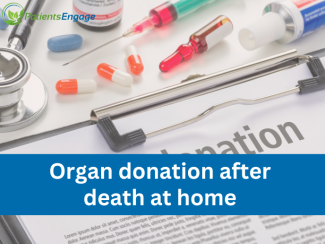
It is often not clear what can be donated when death happens at home. Jaya Jairam, Project Director, MOHAN Foundation clarifies exactly what can be donated and the process that needs to be followed. She envisions an India where no one has to wait for a life-saving organ and tirelessly works to make that a reality.
“You give but little when you give of your possessions. It is when you give of yourself that you truly give,” were the famous words of the renowned poet Khalil Gibran. These words resonate deeply with the selfless act of organ and tissue donation, where one’s final gift can change and save lives.
Eye donation has the power to restore sight to two individuals, allowing them to experience the world anew. Corneas, the outermost transparent portion of the eye, are carefully retrieved from the donor, processed and transplanted into individuals suffering from corneal blindness, giving them a second chance to see and live independently.
Skin donation plays a crucial role in saving lives of burn victims. Severe burns can lead to life-threatening infections, excruciating pain, and prolonged hospital stays. Donated skin provides a protective covering, aids in healing, reduces complications, and enhances the chances of survival for patients with major burn injuries.
Whole-body donation serves as an invaluable contribution to medical education and research. By donating one’s body after death, individuals help train future doctors, surgeons, and medical researchers, enabling them to gain hands-on experience in human anatomy and surgical procedures. This act of generosity advances medical science, leading to innovations that improve treatments and save countless lives.
Through eye, skin, and whole-body donation, individuals leave behind a legacy of hope, healing, and knowledge. Knowing that their loved one is still living through someone else can be both comforting and spiritually healing, offering solace to grieving families. The decision to donate is a noble act that transforms grief into a gift of life and progress for humanity.
Death at Home: What Can Be Donated?
When an individual passes away at home, it is classified as circulatory death – the heart has stopped beating, and respiration and blood circulation have ceased permanently.
When this happens, internal solid organs such as the heart, lungs, liver, kidneys, pancreas, and intestines no longer receive blood supply, making them unsuitable for donation. However, certain tissues, including corneas, skin, bones, cartilage, and heart valves, can still be donated within six hours after death. These tissues can be processed and stored in respective banks for future transplantation.
Right to Donate
It is essential that the right to organ and tissue donation is offered to every individual as a routine part of end-of-life care. Every person has the right to decide how their body should be treated after death and not offering them this option would amount to overlooking or denying them this right. Additionally, encouraging open conversations about organ and tissue donation can lead to more lives being saved.
Death at Home: The Process
If a loved one is nearing the end of life, or passes away at home, their wishes regarding tissue or body donation should be considered immediately, as it is time sensitive. Even if there were no prior discussions, family members can choose to donate tissues or the whole body in support of the noble cause.
Steps to Take:
- Eyes, skin, and the whole body must be donated within six hours of passing.
- Eye and Skin donation:
- Contact the nearest eye and skin banks within 1-2 hours of passing or reach out to organ and tissue donation NGOs such as MOHAN Foundation via their 24x7 toll-free helpline at 1800 103 7100.
- Obtain the death certificate as early as possible, as eye and skin banks require a copy to confirm the cause of death and rule out any medical contraindications (e.g., active cancer, sepsis, COVID19, or other conditions that may prevent donation).
- Prop the head up with a pillow, keep the eyes closed, and place a moist cloth over them to prevent drying. Turn off the fan to prevent the corneas from drying; turn on the air conditioner if available, to keep the room cool until the retrieval team arrives.
- The retrieval teams will provide legal consent forms for a family member to sign.
- Corneas are skillfully retrieved by the eye bank’s trained technicians and the eye is closed shut with tape.
- Skin donation involves retrieving skin from the back and legs, using a specialized razor called ‘Dermatome’.
- The retrieval process takes around 25-30 minutes for each team from the eye bank and skin bank.
- Each team will collect blood samples for viral marker testing at the respective bank, after which the tissues undergo further processing, storage, and distribution.
- The teams take utmost care to ensure there is no disfigurement and conduct the entire process with great respect towards the donor and their family.
- An appreciation certificate is given to the family members by the respective teams once retrieval is complete. While some families may wish to know details of the recipient of their loved one’s tissues, anonymity is maintained by the eye and skin banks.
- After donating eyes and skin, the family may choose to further donate the whole body to a nearby medical college cum hospital (typically, government institutions), for medical education and research, or proceed with customary rituals and funeral arrangements.
- For Whole Body Donation:
- Contact a nearby medical college cum hospital (a teaching hospital) that accepts body donations or reach out to organ and tissue donation NGOs such as MOHAN Foundation via their 24x7 toll-free helpline at 1800 103 7100.
- Ensure that the donation is carried out within six hours, as required by the medical colleges cum hospitals.
- Most medical colleges and hospitals do not provide ambulance services for transportation, so arrangements must be made independently.
- The body must be handed over to the Anatomy Department of the medical college. Some paperwork will be required before the body donation is completed. It is strongly advisable to carry photo IDs of the deceased and a family member carrying out the body donation.
- Once the body is handed over, there can be no funeral; instead, families may plan to hold prayer meetings and pay their respects to the departed soul.
- If the Anatomy Department is closed outside working hours, the family may request to hold the body in the hospital’s own mortuary and inform the Hospital’s Medical Officer about the intent to donate. The donation can be completed once the department reopens on the next working day.
Related Readng: Checklist of Actions After Death At Home
Organ, eye, skin, and whole-body donations are invaluable gifts that can change and save lives. Encouraging awareness and prompt action can make a significant impact in the field of organ transplantation and medical advancements.
Note:

Jaya Jairam was diagnosed with end-stage kidney failure at 33. Following a life-saving kidney transplant from her mother, she committed herself to advancing the cause of organ donation in India.
In 2016, Jaya established the Mumbai Chapter of MOHAN Foundation, where she currently serves as Project Director. Under her leadership, the Foundation has collaborated with the Government of Maharashtra to strengthen deceased organ donation systems in public hospitals. These efforts have contributed to over 450 organ and tissue transplants, thereby saving and enhancing lives, particularly benefitting patients from economically disadvantaged backgrounds. She also initiated a Patient Support Group to provide guidance and emotional support to transplant recipients and patients on waiting lists.
Jaya has completed a Mini Fellowship from Gift of Life Institute, USA. She has presented research and policy papers at both national and international conferences and is a recipient of an International Scientific Grant. Her work has been published in leading peer-reviewed journals, contributing to the global dialogue on ethical, policy, and patient-centered aspects of organ transplantation.






